experimenting with crackle on fabric
Cracks have been hitting the catwalk lately in Paris and New York.
The Rag and Bone Spring collection 2013 used cracked leather and neon green.
Alexander Wang’s Fall/Winter collection for Balenciaga used black and white fabrics that look like cracked leather but are apparently wool jersey coated with acrylic paint and once dry stretched to create cracking patterns.
So I’ve been doing some experiments on different fabrics to see what kind of effects kroma crackle can achieve that might work on wearable art; shoes, bags, jackets and hats.
Once dry and sealed with acrylic medium kroma crackle is flexible and durable. The key to effective cracking is adhesion to the underlying surface, and using a coat of acrylic paint beneath the crackle is the easiest way to ensure a suitable surface for the crackle to bond with.
Fabric surfaces that can lay flat while the crackle dries can be given a layer of crackle applied with a palette knife. Here part of the front flap of a messenger bag has been painted with acrylic colours and given a layer of kroma crackle tinted with a little black acrylic paint. As the crackle gel dries the colours and design can be seen between the cracks.
Using crackle without a layer of acrylic paint or clear medium underneath is possible but the absorbency of the fabric can effect the cracking pattern and take longer to dry than acrylic coated surfaces.
These examples of untinted crackle on uncoated synthetic suede have unusual but quite beautiful cracking patterns.
Once the cracks have formed the crackle slowly turns white.
Securing the edges of the fabric to a rigid surface before applying the crackle can prevent the fabric buckling as it dries.
Lutradur mixed media fabric is ideal for using with crackle, but should be coated with a layer or two of acrylic medium or colour before the crackle is applied. This example shows crackle tinted with shades of green acrylic paint on Lutradur fabric that has also been covered with washes of clear medium
Sometimes a shiny smooth surface will have trouble bonding with acrylics, but this orange vinyl, once coated with acrylic paint, proved to work fine with the crackle, and did not buckle like some other flexible surfaces.
As the crackle dried it pulled the black paint with it revealing the orange vinyl underneath in some places.
Surfaces that cannot lie flat while drying can be crackled using the quick drying DeMented Derma technique. This synthetic ball cap was given a coat of red acrylic paint, then a coat of pva glue, and then a layer of crackle was applied with a brush and dried using a heat tool. The direction of the strokes influences the cracking pattern and produces cracks that are quite different from allowing kroma crackle to dry naturally on a flat surface.
These examples show a few possibilities for projects using crackle on different fabrics. Many other variations are possible, with the key ingredients being kroma crackle, an openness to experimentation, and patience while waiting for the cracks to form – (or pva glue and a heat tool if your’e short on patience or time)


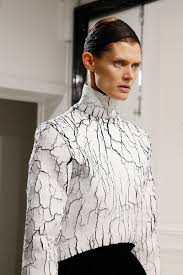
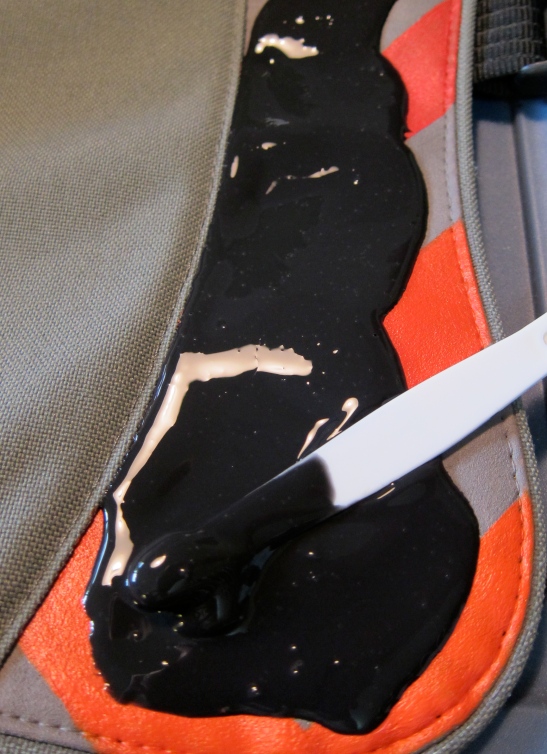
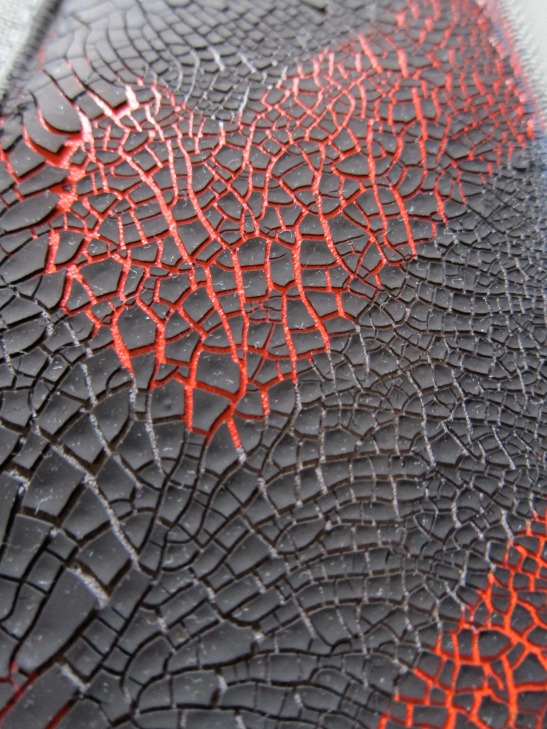
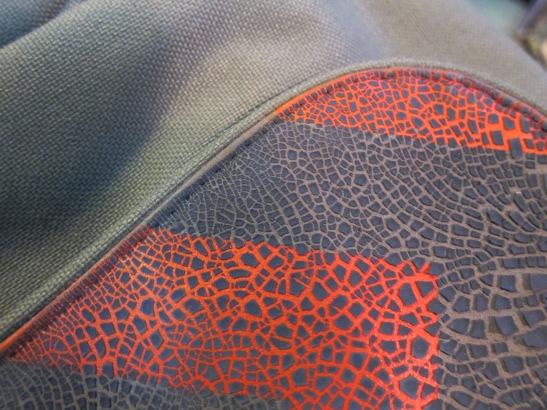



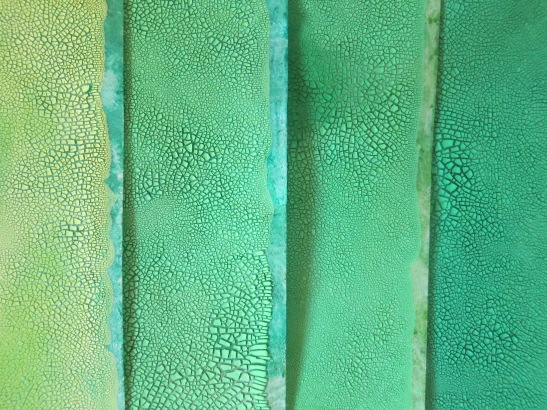

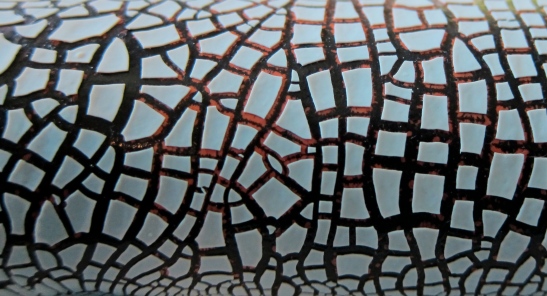


Hello,
This is amazing!
Do you think this type of finish would work on Neoprene or is it likely to flake off?
Hi Katie, Any material that can be coated with a layer of acrylic (either medium or paint) with successful adhesion,can then have the crackle applied on top. Neoprene often has a layer of fabric fused to one side, and depending on the material, this may be a good surface for the acrylic layer to bond with. I’m not so sure that neoprene without a fabric layer would bond with acrylic, but it’s possible that it might work.
Basically, as long as acrylic paint or medium adheres well to the surface, the crackle should work fine.You should make sure that the acrylic layer is completely dry before applying the crackle layer, and once the crackle is cracked and completely dry, another layer of acrylic medium should be applied to make the whole thing strong and flexible.
If you have any more questions, please feel free to call our toll free number: 1888 669-4030 and speak to Kevin or Jessica
Thank you for your interest in our product. Happy Crackling!
Hi I m from Argentina and I bought a paste that is for crack effects on fabric, but NBODY told me anything about using acrylic before this paste.
And when I did it with only the paste, no crack effect at all looks like yours, yours are amazing, I want to do it but I dont understand very well some terms..
Hi from Kevin. The main thing to know is that every crackle past is different. They all work differently and result in different looks and feels. Ours (Kroma Crackle) has worked very well on many fabrics, however, each artist/craft person/designer has worked out their own way of doing it as the product is not specifically designed for fabric. Either way some stiffening of the feel of the fabric results and this should be considered. Hope this helps. Kevin
Hi,
This technique is really beautiful! I’m looking to build a costume for a short film I’m working on. It have a cotton/polyester/spandex leotard for a 3 year old and would require lots of movement. Do you find it flakes on tight fitted clothing? thanks
Jenna.
Hi from Kevin. Thank you for the interest. Even when talented crafters and artists make wonderful crackle on fabric, some stiffening occurs. I would say this would be pushing the limit to expect this to work, but possibly by doing many experiments something could be figured out. Possibly sewing small areas of crackled fabric onto the leotard would work leaving untouched areas of the leotard to stretch. Who knows, this would be tricky and no-one has tried this before. Hope this helps. K.
Hi I just wanted to now what kind of acrylic paint medium should I use, and would it work if I used it on Vilene?
Hi Jona,
Clear Acrylic Medium is available in several different viscosities or thicknesses. It may be easiest to use a fluid (liquid) medium as it soaks into the crackle easily and stengthens its bond with the acrylic paint coated surface. However a thicker medium with a gel-like consistency, can also be used- though it will work best if diluted with water. Any brand of artists quality clear acrylic medium should work fine.
We have not tested crackle on Vilene, so I’m not certain it would be a suitable surface. But Mul-tex (a non woven fabric used in mixed media and fibre arts) seems to be quite similar and we have found crackle works well on that surface as long as it is first sealed with a more than one layer of acrylic medium or paint.
Good luck with your projects. Feel free to call us on our toll free number 1888-669-4030, if you have further questions,
Yours, Helen from Kroma Crackle